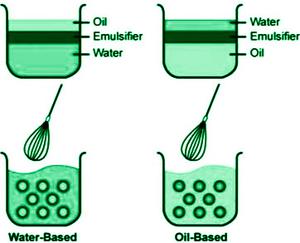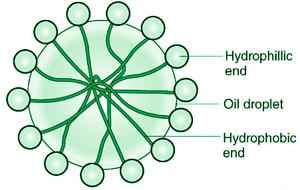乳液——定义、类型、制备、性能
你知道“乳液”来自拉丁语“mulgeo”,意思是“挤奶”吗?牛奶是一种含有多种附加成分的脂肪水乳液。但究竟什么是乳液,它们在我们的日常生活和工作场所中扮演什么角色?
乳液是两种或多种液体的组合,其中一种是微观或什至纳米级尺寸的液滴,散布在另一种液体中。这些通常由处于自然状态的液体成分制成,或者更常见的是通过搅拌等方法制成,假设被混合的流体不具有任何互溶性。让我们仔细看看它们中的每一个。
乳液
“Colloidal solutions in which both the dispersed phase and the dispersion medium are liquids are known as emulsions.”
牛奶中的脂肪球分散在水中,是乳液的一个很好的例子。乳化小球的大小约为10 -6 m。在某些方面,乳液类似于疏液溶胶。
一组称为溶液、凝胶或悬浮液的混合系统也称为乳液。考虑照相乳剂,它是一种明胶凝胶,其中分布着微观晶体。其他类型的乳液包括黄油,它是一种脂肪包水乳液,以及含有卵磷脂的蛋黄。

乳液的种类
基于分散相的性质,乳液的特征如下:
- 水包油乳剂 (O/W):水包油乳剂是一种油作为分散相,水作为分散介质的乳剂。水包油乳液的一个很好的例子是牛奶。牛奶中的液态脂肪球分布在水中。其他的例子还有消失霜等等。
- 油包水乳液(W/O):油包水乳液是一种水作为分散相,油作为分散介质的乳液。油乳液是这些乳液的另一个名称。黄油和冷奶油等乳液是常见的例子。其他例子还有鱼肝油等。
乳液的制备
乳液是通过用高速搅拌器或超声波振动器剧烈搅拌必要的油和水的混合物制成的。简单的机械搅拌会导致乳液不稳定。油和水有分离的趋势。通常加入合适的稳定剂以获得稳定的乳液。乳化剂或乳化剂是稳定成分的名称。最初,乳化剂与油和水混合。
肥皂、去污剂、长链磺酸和亲液胶体如明胶、白蛋白和酪蛋白是可用作乳化剂的化合物的例子。
乳液的性质
在某种乳液的情况下,不同的乳化剂可能表现不同。
例如 :
- 制备水包油乳液需要油酸钠。
- 油包水由镁和油酸钙制成。当将油酸钙引入油酸钠稳定的乳液中时,系统的稳定性会受到影响。水包油乳液在特定比例的 Na + 、Ca +下变得不稳定。如果Ca 2+离子浓度迅速升高,则乳液类型反转,水包油乳液变成油包水乳液。
乳液的鉴定
有几种方法可以确定乳液是水包油还是油包水乳液。以下是乳液的特性。
- 染料测试:用油溶性颜色摇动乳液。如果凝视一滴乳液时颜色可见,则它是一种水包油型乳液。油包水型是一种将整个背景着色的类型。
- 稀释试验:向乳液中加水。如果乳液可以用水稀释,则水作为分散介质,乳液为水包油型乳液。如果油没有被稀释,它会起到分散介质的作用,结果是油包水乳液。
- 电导率测试:在乳液中加入少量电解质(例如:KCl)。如果这使乳液导电,那么水就是分散介质。如果水不在分散相中。
浓度与外观的关系
界面是存在于分散相和连续相之间的边界。由于乳液中存在的相界面会散射不同波长的光,因此乳液具有朦胧的外观。
乳液的颜色由其浓度决定。当所有光线均匀分布时,乳剂呈现白色。低波长光更多地分散在稀释的乳剂中,使乳剂看起来呈蓝色。 “廷德尔效应”是这种现象的名称。如果乳剂足够浓,颜色会扭曲到更长的波长,看起来更黄。
当使用特定种类的乳液(例如纳米乳液和微乳液)时,该体系在颜色上呈现半透明。该属性源于这样一个事实,即光波仅被直径超过入射光波长四分之一的液滴散射。这些系统具有半透明外观,因为粒径小于 100 nm。
乳液的性质
- 乳液表现出胶体溶液的所有特性,包括布朗运动、廷德尔效应和电泳。
- 添加含有多价金属离子的电解质会使小球凝结,从而显示出它们的负电荷。
- 在乳液中,分散颗粒的尺寸比在溶胶中大。它的范围为 1000 至 10,000 Ă。另一方面,尺寸小于悬浮液中的颗粒。
- 通过加热、离心、冷冻等手段,可以将乳状液分离成两种液体。破乳是这个过程的术语。
乳化剂/乳化剂
要理解这一点,我们首先要理解合并的过程。当乳液中的相同颗粒结合在一起产生更大、更大的颗粒时,就会发生聚结,从而导致分散相和分散介质分离。
乳化剂充当分散相和分散介质之间的物理屏障,防止聚结。正如我们所见,乳化剂,如soap,既有亲水端也有疏水端。因此,它们可以附着在极性和非极性材料上。以硬脂酸钠为例。
C 17 H 35 COO-Na 可以表示为:

当添加到 o/w 乳液中时,C 17 H 35 COO– 分子围绕油滴,它们的非极性尾部/疏水末端(烃链)延伸到油中,它们的极性头部/亲水末端(羧酸根离子) 面向水,如图所示。

由于这种布置(分散介质),油(分散相)和水具有更强的粘附力。这种新开发的粘附力将大于油和油之间的内聚力,以及水和水之间的内聚力。结果,油颗粒将不太可能聚集在一起产生更大的颗粒。这有助于通过防止聚结来保持乳液稳定。
这些是为了稳定而添加到乳液中的化合物。以下是乳化剂的诸多特点:
- 它们是同时具有亲水(极性)和疏水(非极性)末端(非极性)的化合物。
- 水和油都可溶于其中。
- 乳化剂在分散相和分散介质之间产生一层,防止分散相颗粒聚集在一起并分离出来。
- 乳化剂有多种形式,包括阳离子、阴离子和非极性。
- 乳液中水油比决定了它是水包油型还是油包水型乳液。另一方面,这取决于两种液体中的哪一种可以将乳化剂乳化到更大的量。
- 如果乳化剂更易溶于水,则水作为分散介质,而油作为分散相,形成水包油乳液。
- 如果乳化剂更易溶于油,油作为分散介质,而水作为分散相。
乳化理论
乳化过程伴随着多种理论,因为它涉及多种过程和机制(化学和物理)。
- 表面张力理论:该理论将乳化定义为当两相之间的界面张力降低时发生的过程。
- 排斥理论:根据这个想法,乳化剂在一个相上产生一层薄膜,从而导致产生小球。这些化学物质之间存在的排斥力有助于它们悬浮在分散介质中。
乳液的应用
- 冶金中的矿石浓度
- 在医学领域
- 肥皂的清洁作用
- 乳化用于消化结肠中的脂质。
- 牛奶是一种水包脂肪乳液,是我们营养的重要组成部分。
示例问题
问题 1:定义乳液。
回答 :
“Colloidal solutions in which both the dispersed phase and the dispersion medium are liquids are known as emulsions.”
问题2:解释乳液的性质。
回答 :
Properties of Emulsion
- Emulsions exhibit all of the properties of a colloidal solution, including Brownian movement, Tyndall effect, and electrophoresis.
- The addition of electrolytes containing polyvalent metal ions coagulates the globules, demonstrating their negative charge.
- In emulsions, the size of the dispersed particles is bigger than in sols. It has a range of 1000 to 10,000 Ă. The size, on the other hand, is less than that of particles in suspensions.
- By heating, centrifuging, freezing, and other means, emulsions can be separated into two liquids. Demulsification is the term for this procedure.
问题 3:解释如何减少乳液中的沉淀和乳化。
回答 :
Sedimentation is the downward movement of particles, whereas creaming is the upward movement of dispersed droplets relative to the continuous phase. The factors that impact creaming rate are comparable to those that determine sedimentation rate. Stokes’ law states that
v = (d(ρ-ρ0)g) / 18η0
问题4:解释乳化剂。
回答 :
These are compounds that are added to emulsions for the aim of stabilization. The following are the many features of emulsifiers:
- They are compounds that have both a hydrophilic (polar) and a hydrophobic (non-polar) end (non-polar).
- Both water and oil are soluble in them.
- Emulsifiers produce a layer between the dispersed phase and the dispersion medium, preventing the dispersed phase particles from clumping together and separating out.
- Emulsifiers come in a variety of forms, including cationic, anionic, and non-polar.
- The ratio of water and oil in an emulsion determines whether it is an oil-in-water or a water-in-oil emulsion. On the other hand, it is dependent on which of the two liquids can emulsify the emulsifier to a greater amount.
- If the emulsifier is more water soluble, the water serves as the dispersion medium, while the oil serves as the dispersed phase, resulting in an oil in water emulsion.
- If the emulsifier is more soluble in oil, the oil serves as the dispersion medium, while the water serves as the dispersed phase.
问题5:如何制备乳液。
回答 :
Emulsions are made by vigorously churning a mixture of the necessary oil and water with a high-speed mixer or ultrasonic vibrators. Simple mechanical stirring results in unstable emulsions. Oil and water have a tendency to separate. A suitable stabilizing agent is usually added to achieve a stable emulsion. Emulsifier or emulsifying agent is the name of the stabilizing ingredient. In the beginning, the emulsifier is combined with the oil and water.
Soaps, detergents, long-chain sulphonic acid, and lyophilic colloids such as gelatin, albumin, and casein are examples of compounds that can operate as emulsifiers.